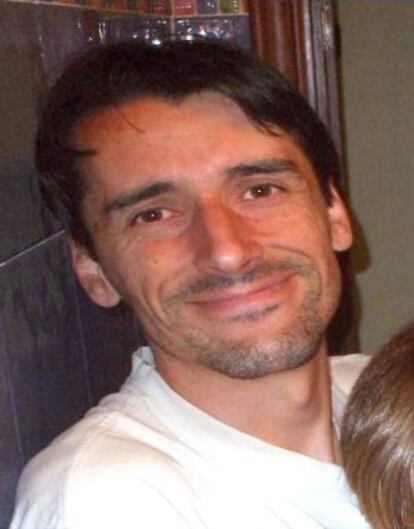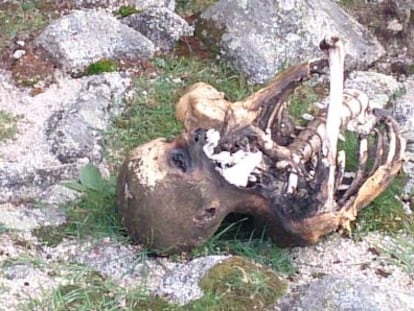Mystery of missing mountaineer solved
Partly mummified body belonged to a cyclist from Madrid who had disappeared in 2011


The mystery of the human remains found in the mountains of Madrid more than four months ago has been solved.
The Civil Guard used DNA testing to identify a partially mummified body found by hikers in La Pedriza on November 1. Following months of investigation, the victim has been identified as Jesús González Gutiérrez, 38, a computer scientist from Madrid who went missing on September 11, 2011.
“Anyone who has not been through this cannot imagine what these two years have been like,” said his partner, Sara, in a telephone interview. The couple had two children.
The body was found in an area called Callejón de las Abejas, near the mountain pass of La Ventana. An autopsy found that the victim had been dead for many months, as was clear by the fact that much of the flesh and bones from the body had apparently been eaten away by vultures and other scavengers.
Preliminary investigations suggested it might be the body of a woman, but later analyses ruled that out. The characteristics of the remains did not seem to match anyone on the missing persons database.
The body was then sent to the Forensic Anatomical Institute, where the anthropologist Enrique Dorado examined the remains and determined that the deceased was a male between 1.65m and 1.75m tall, light-skinned, with thinning chestnut or dark blond hair. He had been dead over a year. But even these clues failed to shed light on the victim’s identity.
Meanwhile, a post was put up on cycling and missing persons online forums: relatives of Jesús González Gutiérrez were reporting that he had disappeared on September 11, 2011 in Madrid. He was described as 38, standing 1.75m, with straight chestnut hair and chestnut eyes. On the day of his disappearance he was wearing beige shorts, a white t-shirt and white running shoes.
His family said he left home with a red-and-white TopBike bicycle and never returned. There was a list of places where he liked to bike: Pozuelo de Alarcón, Boadilla del Monte, Villaviciosa de Odón and Ciudad de la Imagen. “He might have headed out to the Sierra de Madrid [Cercedilla-Cotos] by train. He used to go out for three or four hours and covered many kilometers because he was in good physical shape.”
On January 13, the Civil Guard headquarters in Madrid called on the media for help. The move was successful. Sara’s father called TV station Telemadrid and asked for a contact number at the Civil Guard. Investigators then took saliva samples from Jesús’s father and compared it with the victim’s DNA. It was a match.
“His passions were hiking and biking. When he left, he didn’t say where he was going or how long he would be out. He often went to La Pedriza or Cercedilla,” explained Sara, who had been living with him for 17 years. “He was a normal person who loved being with his children [aged nine and 11] and going out with them. He led a very quiet life.”
Now, the only remaining mystery is what happened to his bicycle. “The most likely scenario is that he chained it to a post in the parking lot and that someone took it after seeing it there for so long. There is no system to identify it,” she added. “Now, after such a long time, at least we know where it was.”
Tu suscripción se está usando en otro dispositivo
¿Quieres añadir otro usuario a tu suscripción?
Si continúas leyendo en este dispositivo, no se podrá leer en el otro.
FlechaTu suscripción se está usando en otro dispositivo y solo puedes acceder a EL PAÍS desde un dispositivo a la vez.
Si quieres compartir tu cuenta, cambia tu suscripción a la modalidad Premium, así podrás añadir otro usuario. Cada uno accederá con su propia cuenta de email, lo que os permitirá personalizar vuestra experiencia en EL PAÍS.
¿Tienes una suscripción de empresa? Accede aquí para contratar más cuentas.
En el caso de no saber quién está usando tu cuenta, te recomendamos cambiar tu contraseña aquí.
Si decides continuar compartiendo tu cuenta, este mensaje se mostrará en tu dispositivo y en el de la otra persona que está usando tu cuenta de forma indefinida, afectando a tu experiencia de lectura. Puedes consultar aquí los términos y condiciones de la suscripción digital.
More information
Últimas noticias
Maduro pleads not guilty before the federal court in New York: ‘I am still the president of Venezuela’
A new test can detect Alzheimer’s from a finger prick
UN team enters Sudanese city of El Fasher after paramilitary massacre: ‘It’s like a ghost town’
A recipe for resistance: Indigenous peoples politicize their struggles from the kitchen
Most viewed
- Gilles Lipovetsky: ‘If you want to live better and fall in love, take Prozac, don’t look to philosophy’
- Alain Aspect, Nobel laureate in physics: ‘Einstein was so smart that he would have had to recognize quantum entanglement’
- Alvin Hellerstein, a 92-year-old judge appointed by Bill Clinton, to preside over Maduro’s trial in New York
- Maduro’s downfall puts China’s relationship with Venezuela to the test
- Why oil has been at the center of Venezuela-US conflicts for decades









































